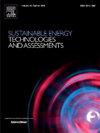Design methodology of a low-cost solar simulator
Abstract
Novel design methodology for low-cost solar simulator for testing standard-sized solar collectors at various incidence angles is introduced. Ray tracing and theoretical approach are used to define development stages. Simulator dimensions are defined in the initial stage. Light source selection and ray tracing analysis are shown for prototype system combining visible spectrum LED reflectors and infrared quartz heaters. Configurations of light sources are assessed using ray tracing to achieve uniform test area irradiation. Prototype assembly and testing are presented and JIS C 8904-9 compliance standard characteristics are determined. Spectral match to solar spectrum results in Class C. Spatial non-uniformity of irradiance is 7.8 % and classified as B. Short-term and long-term temporal instability yields values of 0.39 % and 0.63 %, respectively. Temporal instability achieved Class A. The overall classification of the simulator is CBA. Total simulator power draw is 9.07 kW with a conversion efficiency of 33.6 %. Using the developed prototype, stagnation temperature measurements of polymer collector prototype was conducted using solar simulator and outdoor setup. Prototype collector stagnation temperature without any overheating protection was 95 °C in the simulator and 90 °C in the outdoor test setup. With overheating protection it reached 73 °C in the simulator and 70 °C in the outdoor setup.

 求助内容:
求助内容: 应助结果提醒方式:
应助结果提醒方式:


